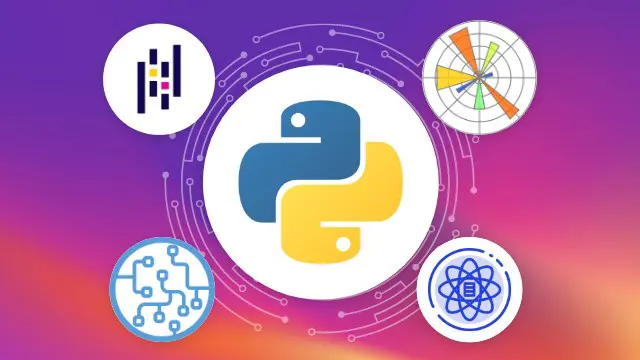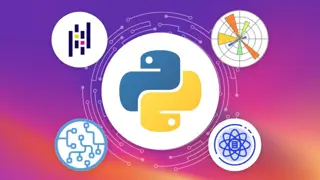
Python: Machine Learning, Deep Learning, Pandas, Matplotlib
Python, Machine Learning, Deep Learning, Pandas, Seaborn, Matplotlib, Geoplotlib, NumPy, Data Analysis, Tensorflow
Oak Academy
Summary
- Reed Courses Certificate of Completion - Free
Add to basket or enquire
Overview
Hello there,
Machine learning python, python, machine learning, Django, ethical hacking, python bootcamp, data analysis, machine learning python, python for beginners, data science, machine learning, django:
Welcome to the “Python: Machine Learning, Deep Learning, Pandas, Matplotlib” course.
Python, Machine Learning, Deep Learning, Pandas, Seaborn, Matplotlib, Geoplotlib, NumPy, Data Analysis, Tensorflow
Machine learning isn’t just useful for predictive texting or smartphone voice recognition. Machine learning is constantly being applied to new industries and new problems. Whether you’re a marketer, video game designer, or programmer, this course is here to help you apply machine learning to your work.
In this course, we will learn what is Deep Learning and how does it work.
This course has suitable for everybody who is interested in Machine Learning and Deep Learning concepts in Data Science.
First of all, in this course, we will learn some fundamental stuff of Python and the Numpy library. These are our first steps in our Deep Learning journey. After then we take a little trip to Machine Learning Python history. Then we will arrive at our next stop. Machine Learning in Python Programming. Here we learn the machine learning concepts, machine learning a-z workflow, models and algorithms, and what is neural network concept. After then we arrive at our next stop. Artificial Neural network. And now our journey becomes an adventure. In this adventure we'll enter the Keras world then we exit the Tensorflow world. Then we'll try to understand the Convolutional Neural Network concept. But our journey won't be over. Then we will arrive at Recurrent Neural Network and LTSM. We'll take a look at them. After a while, we'll trip to the Transfer Learning concept. And then we arrive at our final destination. Projects in Python Bootcamp. Our play garden. Here we'll make some interesting machine learning models with the information we've learned along our journey.
In this course, we will start from the very beginning and go all the way to the end of "Deep Learning" with examples.
The Logic of Machine Learning such as Machine Learning models and algorithms, Gathering data, Data pre-processing, Training and testing the model etc.
Before we start this course, we will learn which environments we can be used for developing deep learning projects.
During the course you will learn:
-
Fundamental stuff of Python and its library Numpy
-
What is the Artificial Intelligence (Ai), Machine Learning, and Deep Learning
-
History of Machine Learning
-
Turing Machine and Turing Test
-
The Logic of Machine Learning such as
-
Understanding the machine learning models
-
Machine Learning models and algorithms
-
Gathering data
-
Data pre-processing
-
Choosing the right algorithm and model
-
Training and testing the model
-
Evaluation
-
-
Artificial Neural Network with these topics
-
What is ANN
-
Anatomy of NN
-
Tensor Operations
-
The Engine of NN
-
Keras
-
Tensorflow
-
-
Convolutional Neural Network
-
Recurrent Neural Network and LTSM
-
Transfer Learning
-
Reinforcement Learning
Finally, we will make four different projects to reinforce what we have learned.
Object-oriented programming (OOP) is a computer programming paradigm where a software application is developed by modeling real world objects into software modules called classes. Consider a simple point of sale system that keeps record of products purchased from whole-sale dealers and the products sold to the customer. An object-oriented language would implement these requirements by creating a Product class, a Customer class, a Dealer class and an Order class. All of these classes would interact together to deliver the required functionality where each class would be concerned with storing its own data and performing its own functions. This is the basic idea of object-oriented programming or also called OOP.
When you enroll, you will feel the OAK Academy`s seasoned developers' expertise. Questions sent by students to our instructors are answered by our instructors within 48 hours at the latest.
Video and Audio Production Quality
All our videos are created/produced as high-quality video and audio to provide you the best learning experience.
You will be,
-
Seeing clearly
-
Hearing clearly
-
Moving through the course without distractions
You'll also get:
-
Lifetime Access to The Course
-
Fast & Friendly Support in the Q&A section
We offer full support, answering any questions.
If you are ready to learn “Python: Machine Learning, Deep Learning, Pandas, Matplotlib”
Dive in now! See you in the course!
Curriculum
-
Python 01:00
-
Intro to Deep Learning with Python 04:44
-
Python Setup 10:30
-
Fundamentals of Python 1:42:16
-
Object Oriented Programming 34:46
-
Numpy Library 3:26:35
-
Optinal NumPy Library 2:17:21
-
Pandas Library 6:56:21
-
(Optional) Recap, Exercises, and Bonus Info from the Pandas Library 3:14:45
-
Matplotlib 1:53:02
-
Seaborn 1:22:15
-
Geoplotlib 43:46
Course media
Description
Hello there,
Machine learning python, python, machine learning, Django, ethical hacking, python bootcamp, data analysis, machine learning python, python for beginners, data science, machine learning, django:
Welcome to the “Python: Machine Learning, Deep Learning, Pandas, Matplotlib” course.
Python, Machine Learning, Deep Learning, Pandas, Seaborn, Matplotlib, Geoplotlib, NumPy, Data Analysis, Tensorflow
Machine learning isn’t just useful for predictive texting or smartphone voice recognition. Machine learning is constantly being applied to new industries and new problems. Whether you’re a marketer, video game designer, or programmer, this course is here to help you apply machine learning to your work.
In this course, we will learn what is Deep Learning and how does it work.
This course has suitable for everybody who is interested in Machine Learning and Deep Learning concepts in Data Science.
First of all, in this course, we will learn some fundamental stuff of Python and the Numpy library. These are our first steps in our Deep Learning journey. After then we take a little trip to Machine Learning Python history. Then we will arrive at our next stop. Machine Learning in Python Programming. Here we learn the machine learning concepts, machine learning a-z workflow, models and algorithms, and what is neural network concept. After then we arrive at our next stop. Artificial Neural network. And now our journey becomes an adventure. In this adventure we'll enter the Keras world then we exit the Tensorflow world. Then we'll try to understand the Convolutional Neural Network concept. But our journey won't be over. Then we will arrive at Recurrent Neural Network and LTSM. We'll take a look at them. After a while, we'll trip to the Transfer Learning concept. And then we arrive at our final destination. Projects in Python Bootcamp. Our play garden. Here we'll make some interesting machine learning models with the information we've learned along our journey.
In this course, we will start from the very beginning and go all the way to the end of "Deep Learning" with examples.
The Logic of Machine Learning such as Machine Learning models and algorithms, Gathering data, Data pre-processing, Training and testing the model etc.
Before we start this course, we will learn which environments we can be used for developing deep learning projects.
During the course you will learn:
-
Fundamental stuff of Python and its library Numpy
-
What is the Artificial Intelligence (Ai), Machine Learning, and Deep Learning
-
History of Machine Learning
-
Turing Machine and Turing Test
-
The Logic of Machine Learning such as
-
Understanding the machine learning models
-
Machine Learning models and algorithms
-
Gathering data
-
Data pre-processing
-
Choosing the right algorithm and model
-
Training and testing the model
-
Evaluation
-
-
Artificial Neural Network with these topics
-
What is ANN
-
Anatomy of NN
-
Tensor Operations
-
The Engine of NN
-
Keras
-
Tensorflow
-
-
Convolutional Neural Network
-
Recurrent Neural Network and LTSM
-
Transfer Learning
-
Reinforcement Learning
Finally, we will make four different projects to reinforce what we have learned.
Object-oriented programming (OOP) is a computer programming paradigm where a software application is developed by modeling real world objects into software modules called classes. Consider a simple point of sale system that keeps record of products purchased from whole-sale dealers and the products sold to the customer. An object-oriented language would implement these requirements by creating a Product class, a Customer class, a Dealer class and an Order class. All of these classes would interact together to deliver the required functionality where each class would be concerned with storing its own data and performing its own functions. This is the basic idea of object-oriented programming or also called OOP.
When you enroll, you will feel the OAK Academy`s seasoned developers' expertise. Questions sent by students to our instructors are answered by our instructors within 48 hours at the latest.
Video and Audio Production Quality
All our videos are created/produced as high-quality video and audio to provide you the best learning experience.
You will be,
-
Seeing clearly
-
Hearing clearly
-
Moving through the course without distractions
You'll also get:
-
Lifetime Access to The Course
-
Fast & Friendly Support in the Q&A section
We offer full support, answering any questions.
If you are ready to learn “Python: Machine Learning, Deep Learning, Pandas, Matplotlib”
Dive in now! See you in the course!
Who is this course for?
- Anyone who has programming experience and wants to learn machine learning and deep learning.
- Statisticians and mathematicians who want to learn machine learning and deep learning.
- Tech geeks who curious with Machine Learning and Deep Learning concept.
- Data analysts who want to learn machine learning and deep learning.
- If you are one of these, you are in the right place. But please don't forget. You must know a little bit of coding and scripting.
- Anyone who need a job transition
- People who want to data analysis, pandas
- People who want to learn artificial intellience, ai, reinforcement learning
- People who want to learn machine learning, deep learning, python pandas numpy, pandas numpy
- People who want to learn data science python, matplotlib, numpy
Requirements
-
Coding skills are a plus
-
Math skills will boost your understanding
-
Be able to download and install all the free software and tools needed to practice
-
A strong work ethic, willingness to learn and plenty of excitement about the back door of the digital world
-
Just you, your computer and your ambition to get started now!
-
Desire to learn machine learning python
-
Desire to learn python learning python
-
Desire to learn data science with python
-
Desire to learn data analysis
-
Desire to learn pandas for data anlaysis
-
Desire to learn matplotlib
Questions and answers
Currently there are no Q&As for this course. Be the first to ask a question.
Certificates
Reed Courses Certificate of Completion
Digital certificate - Included
Will be downloadable when all lectures have been completed.
Reviews
Currently there are no reviews for this course. Be the first to leave a review.
Legal information
This course is advertised on reed.co.uk by the Course Provider, whose terms and conditions apply. Purchases are made directly from the Course Provider, and as such, content and materials are supplied by the Course Provider directly. Reed is acting as agent and not reseller in relation to this course. Reed's only responsibility is to facilitate your payment for the course. It is your responsibility to review and agree to the Course Provider's terms and conditions and satisfy yourself as to the suitability of the course you intend to purchase. Reed will not have any responsibility for the content of the course and/or associated materials.


